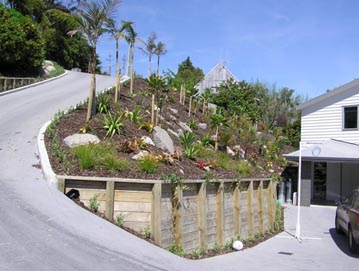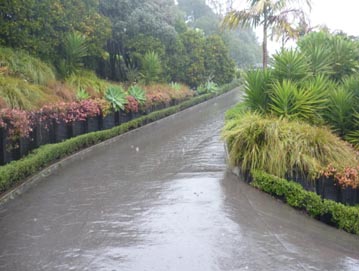
 |
|||
| Sponsors website: | |||
Timber in the landscape: Pine VS HardwoodThe wrong timber choice can lead to a failed landscape in less than 10 yearsBy Todd Layt Choosing the right timber for the right landscape use is unbelievably confusing. Did you know only Sapwood can be treated correctly to withstand outdoor use, but still much of the timber that is treated is Truewood (Heartwood). Is Hardwood or Pine the best for outdoor use? What do the standards really say? The more you research these topics, the more you realise that most users of landscape timber are confused, or worse often mislead or wrongly supplied. Timber is such a beautiful natural product, and can make a landscape design come to life, but what’s the point if the life span is cut short by the wrong choice in timber. The extensive range of products available these days allows you to create decks, landscape gardens, build fences, construct retaining walls, vegetable gardens or even walk ways above wetlands. Getting the choice of timber right is critical to the longevity of each of these landscapes. Pine used in the landscape relies heavily on treatments. Naturally Pine has little durability against the harsh Australian climate compared with traditional Hardwood construction timbers. Therefore a preservation system is used to extend the life of Pine. One thing many landscape contractors and designers do not know is that Truewood cannot be treated, unless lots of cuts are made into it, which is rarely done. To make this article easier to read I will use the much older term Truewood, as the more commonly used term of Heartwood can be easily confused with Hardwood when reading. Only Sapwood takes in the treatments to a level that works in the long run. The Sapwood is the outer living part of the wood and conducts water and nutrients upwards from the roots to the leaves and is a storage area for sugars and starches. As the tree grows the inner sapwood is converted to Truewood. Sapwood naturally decays quicker than Truewood, but where Pine is concerned it can be boosted by adding preservative treatments. Sapwood and Truewood have similar strength and dimensional stability. Now as Pine is generally not suitable for outdoor use without treatments, realistically it is necessary to use Sapwood in outdoor landscapes. Unfortunately many producers still treat Truewood and sell it for outdoor use in situations where it will eventually fail. Always demand that your treated pine for outdoor use is Sapwood, or at least 80% treated Sapwood. What does this mean in practical terms? Pine logs are made from thinning small trees out of plantations, so all the outside wood is Sapwood, and generally at least 80% is Sapwood. The Sapwood is easy to penetrate with the preservatives. These products last a long time. Tests have shown they last 50 to 100 years in many landscape situations if they are treated to H5. (See table 1). Most log types have at least 80% treated Sapwood, so these work great. When it comes to square or rectangular timber like beams, it is rare to find treated pine with at least 80% Sapwood, and just as rare to find Truewood that has been penetrated with preservative. Truewood can only be preserved by very very specialised treatment, which hardly anyone does. It is very rare, so this basically means that this type of treated pine is usually unfit for H4 and H5 use. Usually this type of timber is cut from large trees, and has often very little Sapwood. Sure sometimes you can find square type treated Pine timber with 80% Sapwood, but it is the exception rather than the norm. People like Koppers Logs only do log products from Pine. Quality control! So use treated Pine logs with confidence, but my suggestion is totally avoid treated Pine for sleepers, beams and decking that is going to be in touch with the ground or open to regular wet conditions. This is where Class 1 Hardwood is better, although decking that is in touch with the ground is not a good idea anyway. For decking that is mainly covered or not in touch with the ground, Pine is fine if it is maintained correctly. Another long lasting more durable decking alternative is Mod Wood, a recycled timber plastic composite. www.modwood.com.au So for retaining walls in contact with the ground use only round logs, or variations of round logs. If you want square type sleepers use Hardwood. Now research shows that H4 or H5 treated Pine in logs will outlast untreated and treated Hardwood of all classes except Class 1 treated Hardwood when used in the ground, but H4 and H5 treated Pine with more than 20% Truewood, especially if the Truewood is on the outside, will last far less than Hardwood. So for verticals in the ground use round treated Sapwood pine or hardwood, and for beams and sleepers use Hardwood from either Class 1 or Class 2, or just use treated Pine logs for verticals and horizontals in retaining walls. Some Hardwood is treated which can improve the durability. Hardwood has less Sapwood so when it comes to poles, Pine generally still lasts longer when treated, except for Class 1 Hardwood which is similar to Pine. Some manufactures use very specialised timber and treatments that will give Hardwood even far better durability, but these are very specialised products and are not readily available. Some companies specialise in Hardwood walk ways over wetlands, and these are very durable, but again it is specialised timber. One final problem with young non-round pine is its long term stability. I am sure you have seen pine beams, and planks open to the weather warp and twist over time. The treatment type is also important. Preservatives are either pushed well into the timber under pressure (outdoor use) or sprayed on the exterior of each piece (indoor use). The preservation technology of today allows chemicals to penetrate the Pine substrate and as the preservative dries out the active ingredients are left to do their job for the life of the product. The active ingredients are part of the key to any preservation system as they prevent the onset of decay or resistant insect attack. Each active ingredient varies in effectiveness therefore the loading of the active ingredients in the preservative solution may change depending on what hazard rating the preservative is designed for use in. The hazard rating defines the exposure a piece of timber can withstand in application (See Table 1). Table 1. Pine Hazard Ratings.
The expected life span of landscape products if the correct Hazard Rating is chosen is 40+ years. Therefore what you are about to do will last almost a life time so ensure you do it right. Note: when you cut any treated timber product it is a requirement to reseal the cuts with an approved product to maintain your guarantee. These Hazard Ratings are the Australian Standards for treated timber only. They do not apply to untreated timber. Untreated Hardwood has a different system of rating its toughness and use category, so this often also confuses people, and makes it very hard to compare untreated Hardwood to treated Pine for outdoor use. Confusion! But if you follow the ideas outlined earlier hopefully you will not be too confused. What preservatives are out there? CCA (Copper Chromium Arsenate) treated timber is ideal for any outdoor living project and remains the most common. CCA treated products are available from H4 - H6. The combination of copper chromium and arsenate prevent the onset of decay and resist insect attack. Treated Pine retaining walls allow for many options such as; simple full circle profile logs or half logs, wing splits (Half circle with wings cut of), circle slabs with the top and bottom edges cut off to make them easier to stake, and sleepers. For structural retaining walls these should be H5 products. If it needs to go to council it is probably structural. Unfortunately most suppliers only supply treated Pine to H4 rating. To get H5 you usually need to special order. Now if it is a structural retaining wall, and you use H4 instead of H5, and the wall fails, the landscaper or designer could be liable, as the Australian Standards says H5 should be used for structural retaining walls. Decking should be at least H3 but if it is in contact with the ground it should be H4. For non structural retaining walls, fences and general landscaping where the timber is in contact with the ground, H4 is recommended by the experts. But as stated earlier the Hazard Rating is just part of the equation. Is it Sapwood? Are there knots that weaken the timber? To get the good stuff you really need to go to branded products that guarantee the use of treated Sapwood Pine, or have the manufacturer put in writing that the treated Pine is Sapwood, or find a supplier you trust is supplying what they say they are. Avoid treated Pine sleepers if they are to be in contact with the ground. These sleepers do not treat as well, and regularly fail in the landscape. If you want to use sleepers, use Class 1 hardwood sleepers. If you want to use Pine wood for retaining walls, use logs, or wing splits, as the Sapwood is on the outside. Half logs have Heartwood showing, so they are not as good, but at least only a small part is open to damage so they are OK for non structural use. My advice. Buyer Beware! Table 2.
Now when it comes to comparing Hardwood and treated Pine for durability it gets annoyingly confusing. The Hazard Ratings do not correlate. For example, which are equivalent? How does the toughest untreated Hardwood types in Class 1 and Class 2 compare to H4, H5 or H6 in treated Pine. I could not get a clear and concise and definitive answer, however one well written document which is way too long to go into did a good job of comparing based on a research program. Below is a table I put together based on this document. I choose Sydney as the example. Timber lasts longer in Southern Australia than in the tropics. I have put this document on the internet if you are interested in downloading it. If you use timber I suggest you do.
Table 3.
Note; Most square Pine wood has far less than 80% penetration, so pine beams and sleepers will generally not reach this level protection.
When I first started to research this article I wanted to also write about the working and designing with timber, but I soon found a lot of confusion with the correct selection of timber for landscape use. Anyway, landscape designers should be able to design beautiful natural timber landscapes, and landscape contractors should be trained well enough to work with the timber. Choosing the right timber for the job even seems to confuse many experts, but not all. Some experts helped greatly with this article, and I have listed them below. Finally one word of advice, buyer beware, make sure you demand the right timber for the job. Do not except a lower Hazard Rating than you ask for.
Expert advice provided by; Jeff Price From ITI, www.itiaustralia.net This web site has concise information and lots of information about many branded landscape timber products. C E MacKenzie Timber Queensland Limited www.fwpa.com.au www.timberqueensland.com.au |
|
|||||||||||||||||||||||||||||||||||||||||||||||||||||||||||||||||||||||||||||||||||||||||||||||||||||||||||||||||||||||||||||||||||||||||||||||||||||||||||||||||||||||||||||||||||||||||||||||||||||||||||||||||||||||||||||||||||||||||||||||||||||||||||||||||||||||||||||||||||||||||||||||||
|
||||||||||||||||||||||||||||||||||||||||||||||||||||||||||||||||||||||||||||||||||||||||||||||||||||||||||||||||||||||||||||||||||||||||||||||||||||||||||||||||||||||||||||||||||||||||||||||||||||||||||||||||||||||||||||||||||||||||||||||||||||||||||||||||||||||||||||||||||||||||||||||||||
|
||||||||||||||||||||||||||||||||||||||||||||||||||||||||||||||||||||||||||||||||||||||||||||||||||||||||||||||||||||||||||||||||||||||||||||||||||||||||||||||||||||||||||||||||||||||||||||||||||||||||||||||||||||||||||||||||||||||||||||||||||||||||||||||||||||||||||||||||||||||||||||||||||
|
||||||||||||||||||||||||||||||||||||||||||||||||||||||||||||||||||||||||||||||||||||||||||||||||||||||||||||||||||||||||||||||||||||||||||||||||||||||||||||||||||||||||||||||||||||||||||||||||||||||||||||||||||||||||||||||||||||||||||||||||||||||||||||||||||||||||||||||||||||||||||||||||||
|
||||||||||||||||||||||||||||||||||||||||||||||||||||||||||||||||||||||||||||||||||||||||||||||||||||||||||||||||||||||||||||||||||||||||||||||||||||||||||||||||||||||||||||||||||||||||||||||||||||||||||||||||||||||||||||||||||||||||||||||||||||||||||||||||||||||||||||||||||||||||||||||||||
 |
||||||||||||||||||||||||||||||||||||||||||||||||||||||||||||||||||||||||||||||||||||||||||||||||||||||||||||||||||||||||||||||||||||||||||||||||||||||||||||||||||||||||||||||||||||||||||||||||||||||||||||||||||||||||||||||||||||||||||||||||||||||||||||||||||||||||||||||||||||||||||||||||||
 |
||||||||||||||||||||||||||||||||||||||||||||||||||||||||||||||||||||||||||||||||||||||||||||||||||||||||||||||||||||||||||||||||||||||||||||||||||||||||||||||||||||||||||||||||||||||||||||||||||||||||||||||||||||||||||||||||||||||||||||||||||||||||||||||||||||||||||||||||||||||||||||||||||